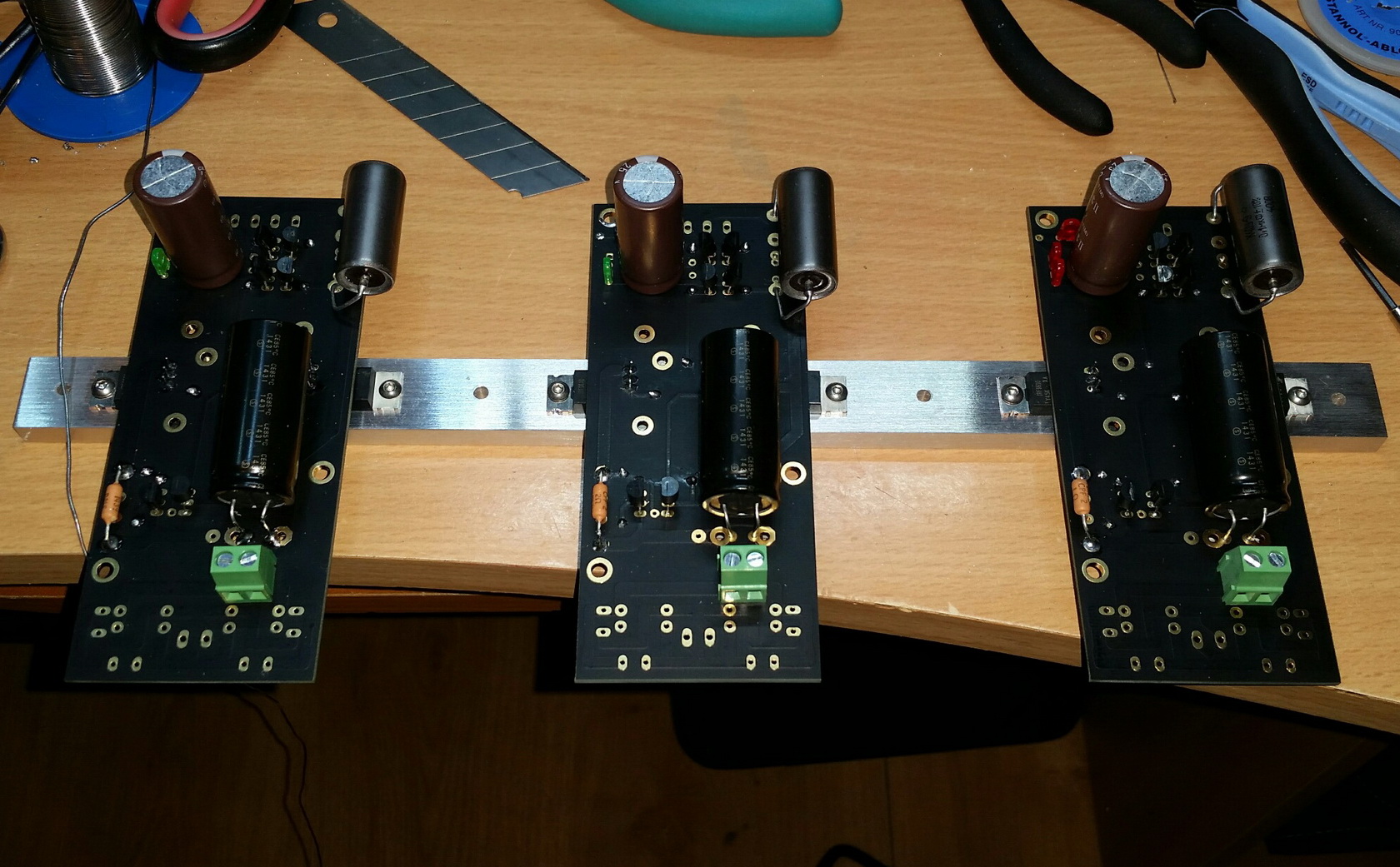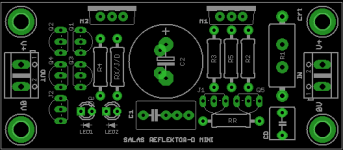Hello.
I have a plan to use two ref-d's to power the avcc of three BuffaloIII's.
One for left channel x 3 and one for right channel x 3. It's for a 3-way dsp,
therefore so many dac's. I have looked for it but haven't found how much
current each avcc will draw, so if anyone here has a clue 🙂 The plan is to
stack the dacs on top of each other and run pins through the avcc
connections. How much current would be recomended as overhead ? 3-4
times what's drawn ? I will still use the regular 5,25v input with either the
Placids I'm using now or a set of 3xBiB.
I have a plan to use two ref-d's to power the avcc of three BuffaloIII's.
One for left channel x 3 and one for right channel x 3. It's for a 3-way dsp,
therefore so many dac's. I have looked for it but haven't found how much
current each avcc will draw, so if anyone here has a clue 🙂 The plan is to
stack the dacs on top of each other and run pins through the avcc
connections. How much current would be recomended as overhead ? 3-4
times what's drawn ? I will still use the regular 5,25v input with either the
Placids I'm using now or a set of 3xBiB.
According to the 9018's datasheet, each AVCC supply needs to be 3.3V+/-5% and supply 25mA nominal.
I believe that the Ref-D has a minimum CCS current of ~300mA (with a 2 ohm R1), so you should be OK with that.
I believe that the Ref-D has a minimum CCS current of ~300mA (with a 2 ohm R1), so you should be OK with that.
According to the 9018's datasheet, each AVCC supply needs to be 3.3V+/-5% and supply 25mA nominal.
I believe that the Ref-D has a minimum CCS current of ~300mA (with a 2 ohm R1), so you should be OK with that.
Thanks 🙂
Ok, so three Ref-d's are almost done, all for dc input.
Two 3,3v for avcc supply: R1/2ohm, green/jump/62ohm,
C1/0,1uf K40pio +0,01uf mkp, C2 SilmicII 25v/1000uf + 0,1uf mkp,
Cm/ Silmic 16v/2200uf + 0,1uf mkp.
One for 5,2v WaveIO: R1/2ohm, red/red/red, same caps.
The plan is to mount them to the underside of a 500x500x1,5mm
copper sheet metal. Should be enough colling I think.
Two 3,3v for avcc supply: R1/2ohm, green/jump/62ohm,
C1/0,1uf K40pio +0,01uf mkp, C2 SilmicII 25v/1000uf + 0,1uf mkp,
Cm/ Silmic 16v/2200uf + 0,1uf mkp.
One for 5,2v WaveIO: R1/2ohm, red/red/red, same caps.
The plan is to mount them to the underside of a 500x500x1,5mm
copper sheet metal. Should be enough colling I think.
2 Ohm is not a minimum absolute, for 25 ma you may very well use R1 3 Ohm =200ma CSS ,you will have still much margin.
2 Ohm is not a minimum absolute, for 25 ma you may very well use R1 3 Ohm =200ma CSS ,you will have still much margin.
Ok, I will keep it in mind if it will run to hot 🙂
Guys I want your opinions if you may.
I got an idea to also have a smaller configuration for space challenged builds. Not that self sufficient or that versatile version as the regular Ref-D so to save in size i.e. DC input only, external sinking only, two wire output only, R6=JFET only. The MOSFETS located at one side's edge so to can mount/cool them either on side panel, bottom panel, common external side sink. In all those three mounting styles they need be electrically isolated.
The layout is ready at 76mmx33mm. Kept it through hole technology so it can be assembled or serviced with components we can still see and hold. I named it Reflektor-D Mini.
I want to know if you think it will be useful enough as an alternative so I will propose it to also be included in the GBs?
I got an idea to also have a smaller configuration for space challenged builds. Not that self sufficient or that versatile version as the regular Ref-D so to save in size i.e. DC input only, external sinking only, two wire output only, R6=JFET only. The MOSFETS located at one side's edge so to can mount/cool them either on side panel, bottom panel, common external side sink. In all those three mounting styles they need be electrically isolated.
The layout is ready at 76mmx33mm. Kept it through hole technology so it can be assembled or serviced with components we can still see and hold. I named it Reflektor-D Mini.
I want to know if you think it will be useful enough as an alternative so I will propose it to also be included in the GBs?
Attachments
Sems like a good idea, I probably would have bought them instead of the
ones I actually bought.
ones I actually bought.
There need be some already proper spare DC line to feed it or some available space for Tx and rectification+filter cap somewhere in the box though. But the mini itself will be more maneuverable to position.
I have mounted the small parts on the top side and what you see is the bottom
side. That way i could get the parts that need cooling turned the right way.
They are mounted to a hard aluminum bar that will be bolted to the copper
sheet metal.

side. That way i could get the parts that need cooling turned the right way.
They are mounted to a hard aluminum bar that will be bolted to the copper
sheet metal.

Creative mounting indeed. You have also insulated M1s & M2s I would think. Now I see why you particularly would prefer a mini as I described it in the previous page. You don't need the AC input or the self sinking in your build. You could even chop off the rectifiers end. About oil capacitor, other C1 biggie, or large local Cfilter DCin, the mini would not have the space though.I have mounted the small parts on the top side and what you see is the bottom
side. That way i could get the parts that need cooling turned the right way.
They are mounted to a hard aluminum bar that will be bolted to the copper
sheet metal.
2 Ohm is not a minimum absolute, for 25 ma you may very well use R1 3 Ohm =200ma CSS ,you will have still much margin.
That is good to know. 🙂
Is there an effective lower limit to the CCS current?
The lowest regulating limit is just your load consumption plus literally 3-4 mA before the shunt voltage section will current starve and cut off dropping the output voltage. But you would like it to work in better spec than at the edge of functioning. If you can have 100-150mA spare current is alright, 200mA is good, 300mA is very good. And you can possibly feel the difference depending on how susceptible is the device you use it for because the modulation distortion on the rail falls along more spare current.
Its the same circuit with same component designations as Ref-D but without sinks, rectifiers, large filter capacitor, instead of R6 it has J2. Output connector is two pins. I have added an image in post #567
The lowest regulating limit is just your load consumption plus literally 3-4 mA before the shunt voltage section will current starve and cut off dropping the output voltage. But you would like it to work in better spec than at the edge of functioning. If you can have 100-150mA spare current is alright, 200mA is good, 300mA is very good. And you can possibly feel the difference depending on how susceptible is the device you use it for because the modulation distortion on the rail falls along more spare current.
OK, message received. Never go below 2R for R1. 😛
Its the same circuit with same component designations as Ref-D but without sinks, rectifiers, large filter capacitor, instead of R6 it has J2. Output connector is two pins. I have added an image in post #567
Thanks, seems to be holes missing at "RX/J/D".
You mean the extra pads inside Rx/J/D for a third LED we have in the Ref_D to reach 7V also. That was to can be used used as pre-reg for digital unit with own 5V LDOs. I did not see much use of 7V here so I forgot to include it again. Good catch, I will include it.
You mean the extra pads inside Rx/J/D for a third LED we have in the Ref_D to reach 7V also. That was to can be used used as pre-reg for digital unit with own 5V LDOs. I did not see much use of 7V here so I forgot to include it again. Good catch, I will include it.
I have done one card with three red leds for 5,2v 😕
The lowest regulating limit is just your load consumption plus literally 3-4 mA before the shunt voltage section will current starve and cut off dropping the output voltage. But you would like it to work in better spec than at the edge of functioning. If you can have 100-150mA spare current is alright, 200mA is good, 300mA is very good. And you can possibly feel the difference depending on how susceptible is the device you use it for because the modulation distortion on the rail falls along more spare current.
So to best perf. if my device use 50-75 Ma, i should use R1 1,8 Ohm or even 1,5 Ohm,right?
Nice the Reflektor-D Mini🙂
- Home
- Amplifiers
- Power Supplies
- Reflektor-D builds
